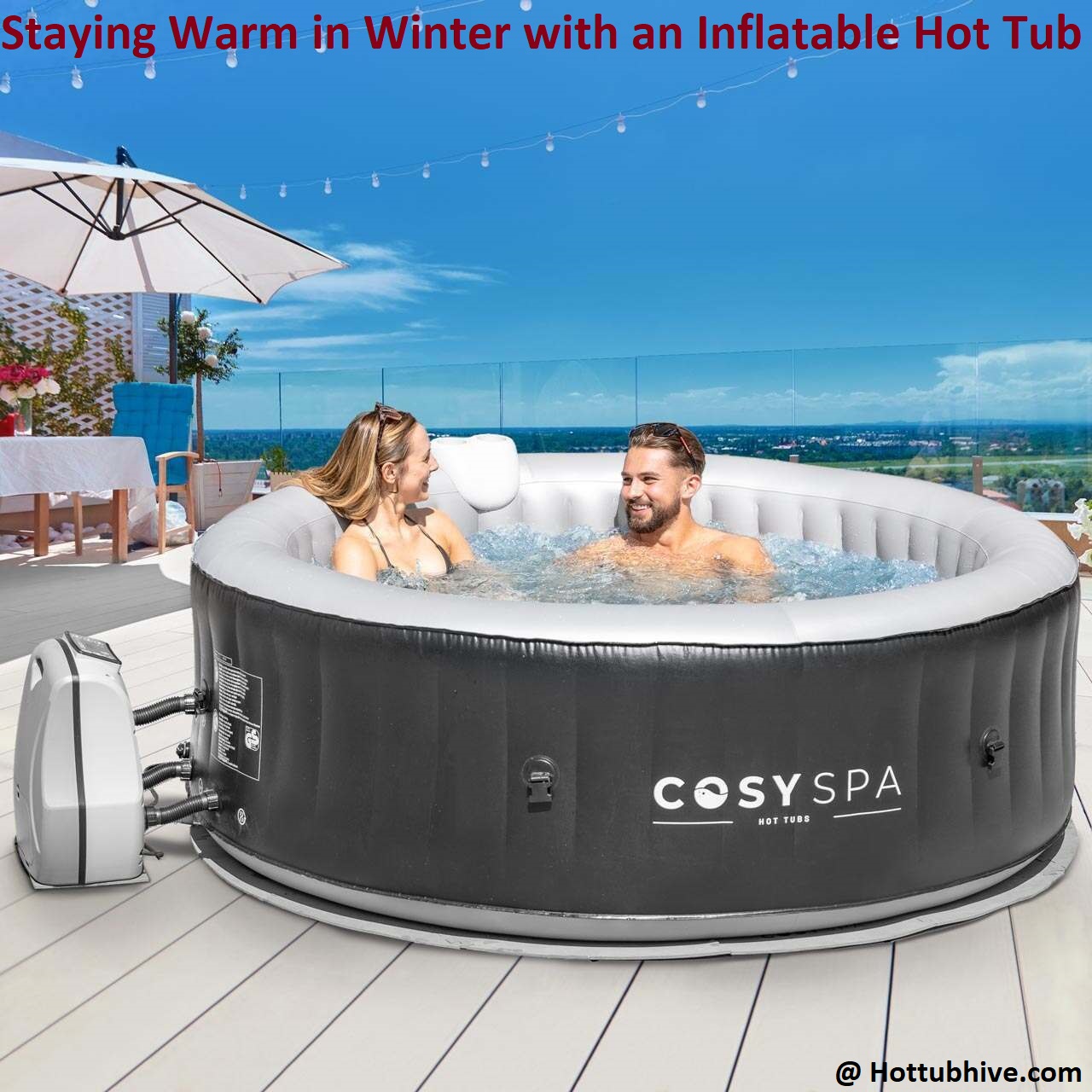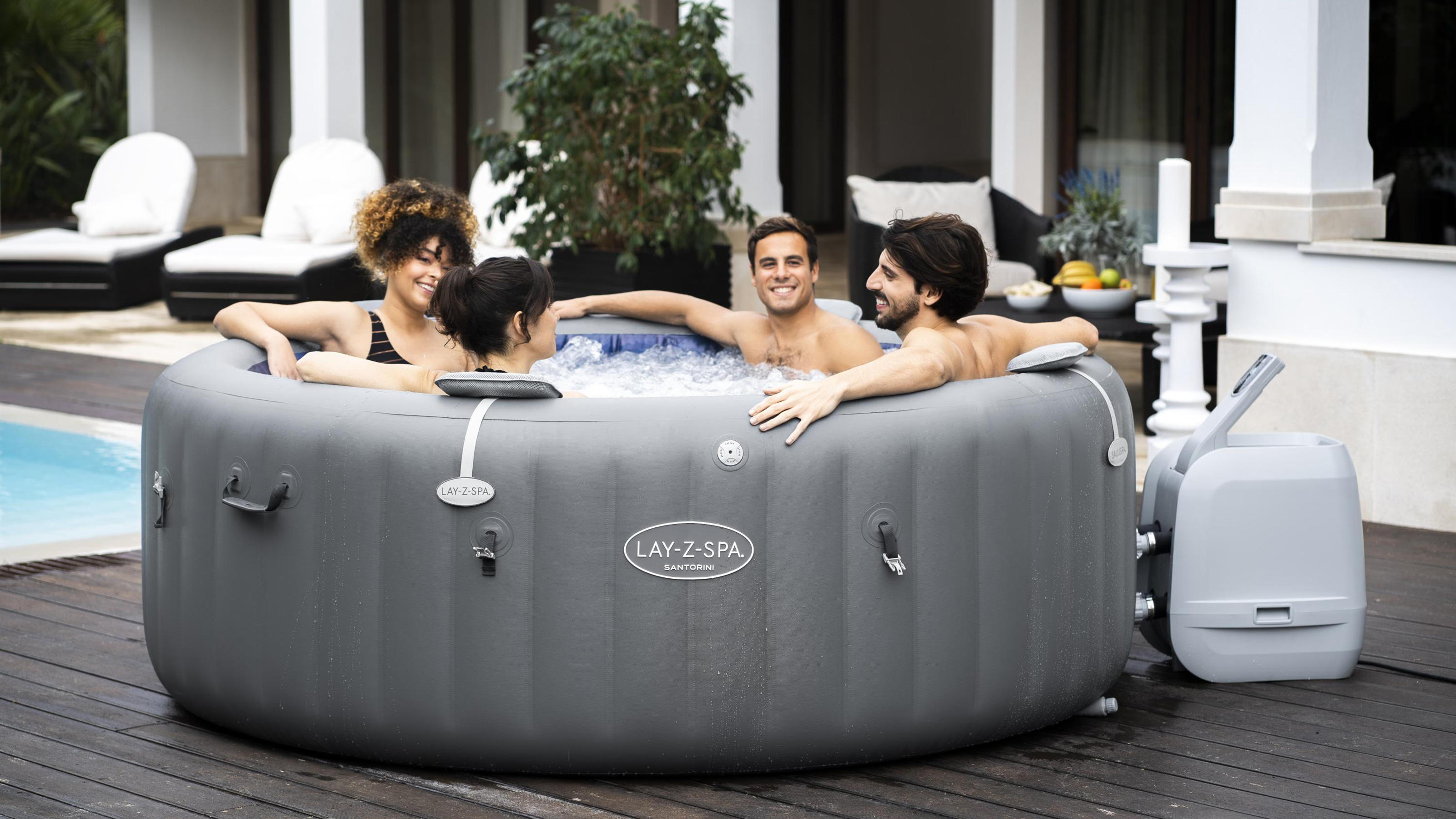Do you dread the cold winter months? Do you want to enjoy a selection of outdoor activities, while staying warm and cozy?
Inflatable hot tubs provide an affordable and convenient way to stay warm all winter long. With this complete guide, you’ll learn how to make the most of your inflatable hot tub experience.

Greeting everyone — winter is here! Even though winter can be harsh, it’s the perfect time to enjoy a hot tub soak with friends and family. Inflatable hot tubs provide a great opportunity for relaxation and relief from the cold during colder months. Plus, when compared to traditional hot tubs, inflating your own spa helps you save money!
In this guide, we’ll discuss the basics of inflating your own spa and staying warm in winter. We’ll cover topics such as setting up your inflatable hot tub, proper maintenance, tips for keeping it warm during chilly seasons, and more. With these tips in mind, you can relax knowing that you are fully prepared to enjoy the relaxing benefits of owning a personal hot tub. Let’s get started!
Explanation of the importance of staying warm during winter
Staying warm is an important part of staying healthy during the winter months. Prolonged exposure to cold temperatures can lead to frostbite and hypothermia, two dangerous conditions that should be avoided if at all possible. For this reason, having access to a reliable source of warmth during the winter months can help keep you comfortable and healthy. An inflatable hot tub can provide a safe and accessible method of keeping warm in colder climates.
Inflatable hot tubs are typically filled with hot water, which creates a warm environment for those inside the tub. They also come with safety features like temperature monitors, which ensure the water does not get too hot or too cold for those utilizing it. In addition to providing warmth in wintertime temperatures, inflatable hot tubs also offer other benefits like relaxation and stress relief via massage jets and aromatherapy lights, allowing users to simultaneously enjoy comfort while engaging in stress-relieving activities during other times of the year.
Inflatable hot tubs are often an easy-to-install option due to their lightweight build and simple setup instructions. Additionally, they also tend to take up less space than traditional non-inflatable models and are easier to transport due to their collapsible nature. This makes them ideal for those living in temperate climates who may be expecting occasional cold snaps or looking for something that they can utilize when outside temperatures dip below freezing during the winter months.
Brief overview of inflatable hot tubs
Inflatable hot tubs are easy to set up and provide an ideal way to stay warm when the temperature outside drops. They come in a range of shapes and sizes, allowing you to choose what fits your space. They are usually quick to assemble, making them a convenient solution for those looking for a fast way to enjoy the hot water.
Inflatable hot tubs can be easily transported from place to place, so you can enjoy any location with ease. Debris is simple to filter out of the system, and chemical levels can be adjusted as needed to ensure proper maintenance. With an inflatable hot tub, you can stay warm all winter long!
Thesis statement outlining the purpose of the guide
This guide seeks to provide comprehensive and practical information on the steps necessary for staying warm in the winter with an inflatable hot tub, from selecting the right size and features for a given environment to setting it up, using it, and taking care of it over time.
Additionally, this guide includes information on health benefits associated with using an inflatable hot tub in colder climates as well as advice on what to avoid when preparing for use.
Benefits of using an inflatable hot tub during winter
Using an inflatable hot tub is a great way to stay warm during the winter months, regardless of whether you have access to a heated pool or not. Not only will it provide you with relief from the cold outside, but an inflatable hot tub also offers numerous other benefits. Here are some of the advantages that make it a stand-out choice in winter:
- Easy setup: An inflatable hot tub is incredibly easy to set up as all that is required is access to a power source and adequate ventilation. It can be installed within minutes and once filled up, provides instantaneous, steaming hot water perfect for providing warmth and relieving muscle aches and pain.
- Cost-effective heating: Inflatable hot tubs are significantly less expensive than traditional hot tubs that require tanks or larger plumbing systems connected to your home’s water system. Additionally, they don’t require any expensive installation process which further reduces overall costs for winter use.
- Comfort in colder climates: Hot tubs provide excellent insulation against cold temperatures but air-filled models are even better at creating a warm microclimate inside and around the area where they’re placed – creating a more comfortable environment throughout cold winter nights or chilly mornings.
- Versatility and convenience: The fact that inflatable hot tubs take up very little space when deflated means that you can easily move them around if needed for convenience purposes or bring them indoors during bad weather conditions. This makes them highly versatile tools for keeping you warm during the colder months of the year while also providing re-assuring relaxation and comfort when needed most!
Discuss the advantages of using an inflatable hot tub in cold weather
Using an inflatable hot tub in cold weather can be a great way to warm up and relax. This type of spa is easily transportable, so it’s ideal for those who live in temporary or seasonal locations, or don’t have space for a full-sized spa. It’s also an affordable option, as many models cost less than their permanent counterparts.

Inflatable hot tubs are far easier to set up than traditional spa models. They typically feature quick heating up times and come with built-in insulation that stays warm longer, making them ideal for winter weather. Additionally, inflatable spas are often lighter and more portable than other types of spas and will require less time to cool down after use.
Inflatable hot tubs provide excellent relief from the cold winter weather by providing deep tissue massage that helps to relieve muscle pain and stiffness caused by the decrease in temperature outside. The water jets provide excellent hydrotherapy that improves circulation in your body and releases tension from your muscles. It also serves as a great way to unwind when you want some alone time with yourself or with family members after spending a day outside in the cold winter air.
In addition to providing relaxation benefits, an inflatable hot tub is also widely considered an effective way to reduce stress levels associated with extreme weather conditions such as frigid winter temperatures or sudden storms that cause electrical outages during periods of high demand heating needs. The combination of the warmth generated by the hot water circulating around your body and its buoyancy effect helps reduce tension in both muscles and mind while at the same time improving balance via controlled hydrostatic pressure combined with movement activities experienced while swimming against water jets provided by this type of spa pool system technology feature.
Highlight the health benefits of using an inflatable hot tub during winter
Using an inflatable hot tub in the winter provides many health benefits. The warm water helps improve circulation, reduces stress, alleviates muscle pain and tension, relieves joint stiffness, and can help improve sleep quality. All of these physical and mental health benefits can help individuals stay warm through the winter months. Additionally, the warm water helps people to relax and unwind after a long day or after a day enjoying outdoor winter activities like skiing or snowshoeing.
The controlled temperature of the water allows it to stay comfortable all year long. Unlike other hot tubs that require large heaters to keep them at a comfortable temperature all season long, an inflatable one comes with an adjustable thermostat so you can set your own temperature preference – it just takes a few minutes for the heater to get going. Plus, most inflatable models come with temperature gauges so you can easily monitor and adjust your ideal temperature while staying safe in the warm water.
Furthermore, most inflatable hot tubs feature dual-port setups so that you could hook up another air jet or jetted heating pack for additional heat relief during your time in the tub. In this way, you can really feel comfortable and enjoy a complete spa experience without leaving home!
III. Choosing the right inflatable hot tub for winter
When shopping for an inflatable hot tub for the winter time, there are a few factors to consider in order to ensure you get the most out of your purchase. Here are some of the key points to investigate in order to make an informed decision:
- Size – The size of your hot tub will depend on how many people and/or pets you plan on having in it. Consider buying one that is slightly bigger than what you think you will need because, as we all know, things tend to become more crowded once everybody wants to get in!
- Insulation – If purchasing an inflatable hot tub for winter use, it is important to make sure it has good insulation properties so that it keeps its temperature more effectively during colder weather. Canvas-covered models that are designed with air chambers provide the best insulation while also allowing easy access and installation.
- Heating System – Ensure that the heating system is efficient and reliable by researching reviews from customers who have already purchased this item. A good heating system will also be able to maintain temperature quickly and consistently at designated settings during freezing conditions so that your hot tub stays warm all winter long!
- Accessories – It can be helpful to consider purchasing accessories such as covers or stand-alone structures which provide further insulation or shade from snow and wind during particularly cold days outdoors when using the hot tub during winter months.
- Budget – As with any purchase, it is important to set a budget before looking into various products, especially if cost can be a restricting factor when selecting the right product for you and your family’s needs. Compare options carefully within your budget range – there might be more features available than initially thought!
Discuss the factors to consider when choosing an inflatable hot tub for winter use
When purchasing an inflatable hot tub for winter use, there are several factors which should be considered. Size, insulation, and heating types can all affect the longevity of your tub.
Size: A larger inflatable hot tub will allow you to fit more people inside at one time and be able to sit in it without being cramped. In addition, a larger diameter will require more to heat the water up and provide a longer lasting heat retention time due to the added surface area in contact with the air around it.
Insulation: Many of the higher end models come with insulation-lined walls that provide extra protection against cool ground temperatures that could potentially leave you feeling cold after using the hot tub for an extended period. Be sure to check this feature before purchasing an inflatable hot tub for winter use.
Heating Types: Electric or gas heated hot tubs offer varying levels of heat retention due to their different sources of energy. Electric models are typically preferred among home owners since they are relatively inexpensive and easy to install, while gas models tend to have better insulation but take longer amounts of time to get up and running.
Highlight the features that make an inflatable hot tub suitable for winter use
Inflatable hot tubs are designed to be used outdoors all year round and deliver a similar, comfortable experience as their conventional counterparts. Before you decide to buy one for yourself, here are some of the features that make an inflatable hot tub suitable for winter use:

- Durability and stability – Most inflatable hot tubs are made of high-quality PVC material and can stand up to cold temperatures, as well as wear and tear while maintaining its shape. Many models also have thick walls, which help insulate the interior of the tub and keep the heat inside.
- Fast heating capabilities – Most inflatable hot tubs have built-in electric heaters which heat water rapidly without having to wait endlessly. That way your hot tub is always ready when you need it!
- Flexible jets – Inflatable hot tubs often come with adjustable jets for added comfort. You can switch the jet settings to create powerful currents or a gentle massage effect depending on your preference. adjust them or even shut them off completely so your session is just perfect every time.
- Cost Effective– Compared to regular hot tubs, most inflatable models require less maintenance costs due to their relatively low price points when compared with equivalent traditional models head on head at an equivalent size capacity. A great way of adding extra value during this cold season!
Conclusion
In conclusion, an inflatable hot tub delivers all of the benefits of its hard-shell equivalent while being more convenient to set up and tear down. It can help make outdoor activities like watching football or winter stargazing with friends comfortable in cold weather conditions when coupled with a high quality heater. Furthermore, having your own portable hot tub ensures maximum privacy, so you can sit back and relax without worrying about who may be watching.
Whether you’re in the market for a fully self-contained inflatable hot tub for regular use or one that is easy to pack away and take on the go, there is an option available to meet your needs. With the right amount of research, preparation and maintenance you can ensure that your purchase will last you years down the line.
FAQ’S
What can I put under my inflatable hot tub to keep it warm?
You can use various materials such as foam tiles, rubber mats, or a hot tub mat to insulate the bottom of the inflatable hot tub and keep it warm.
Do inflatable hot tubs retain heat?
Inflatable hot tubs can retain heat, but they can also lose heat quickly depending on the outside temperature, insulation, and cover.
What is the most efficient way to heat an inflatable hot tub?
The most efficient way to heat an inflatable hot tub is to use a hot tub cover to retain heat, and a high-quality electric heater with a timer and thermostat to regulate the temperature.
How long does it take an inflatable hot tub to heat up in winter?
It can take several hours for an inflatable hot tub to heat up in winter, depending on the outside temperature, size of the hot tub, and heater capacity.
Should I leave my inflatable hot tub on all the time?
It is not necessary to leave your inflatable hot tub on all the time. You can turn it on when you want to use it and turn it off when you are finished.
How do I protect my hot tub from extreme cold?
You can protect your hot tub from extreme cold by using a hot tub cover, insulating the bottom, and using a heater to maintain a safe temperature.
Can I leave my inflatable hot tub empty in winter?
It is recommended to drain and store your inflatable hot tub in a warm and dry place during the winter to prevent damage from freezing temperatures.
How do you insulate a hot tub for the winter?
You can insulate a hot tub for the winter by using a hot tub cover, insulating the bottom, and using additional insulation such as foam boards or bubble wrap.
How do inflatable hot tubs get hot?
Inflatable hot tubs get hot through an electric heater that is connected to the hot tub’s pump system, which circulates the water and heats it up.
Is it safe to put inflatable hot tub in house?
It is safe to put an inflatable hot tub in a house, but you need to ensure proper ventilation and humidity control to prevent moisture buildup and potential damage to the house.
See Also-
- Best 2 person hot tub 2023
- Best 3 person hot tub 2023
- Best 4 person hot tub 2023
- Best 6 person hot tub 2023
- Best 110v hot tub 2023


